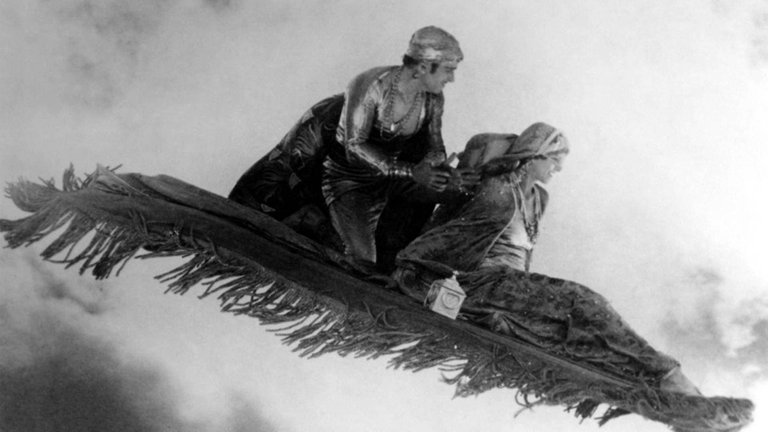Film Review: The Thief of Bagdad (1924)

Many grand classics of cinema represent an acquired taste and very few of them can provide simple escapist fun general audience is expecting from today’s summer blockbusters. One of those rare exceptions is The Thief of Bagdad, 1924 fantasy adventure epic directed by Raoul Walsh, known as one of the most expensive, most popular and most highly regarded works of silent era Hollywood.
The plot, loosely inspired by Arabian Nights, is set in medieval Bagdad. Douglas Fairbanks, who also produced the films, stars as Ahmed, man who, by his own words, “takes what he wants” and supports his carefree life by stealing, while using ingenuity and superb athletic abilities to escape consequences of his actions. One day he steals magic rope who would later use to penetrate palace of Caliph (played by Brandon Hurst) in order to steal treasure. Instead he sees beautiful Princess (played by Julianne Johnson) and falls hopelessly in love with her. Determined to win her at all cost, he pretends to be Prince of the Isles and joins group of suitors that include Prince of Indies (played by Noble Johnson), Prince of Persia (played by Mathilde Comont) and Cham Shang, Prince of the Mongols (played by Sojin Kamiyama). Although Princess falls in love with him and chooses him to be her next husband, Ahmed is suddenly struck by conscience and confesses his deception, resulting in being flogged and barely leaving palace alive. Despondent, he seeks advice from Imam (played by Charles Belcher) who tells him that he must take great and dangerous quest before he can win happiness. In the meantime, three remaining suitors are given seven months to bring most valuable treasure to Caliph and Princess, and the suitor that wins the contest will win Princess’ hand. Cham Shang, on the other hand, wants not only Princess, but also Baghdad, so he brought secret Mongol army within city walls.
The Thief of Bagdad was made at the zenith of Fairbanks’ popularity, based on starring in swashbuckling epics. This was Fairbanks’ most ambitious project by that time and its alleged budget of 2 million US$ (actually almost half smaller) was widely reported to break records of cinema history. Most of it was spent on incredibly lavish and large sets designed by William Cameron Menzies, which recreated old Baghdad and various locations of Orient with strange but interesting mix of traditional and Art Nouveau style. The film also featured special effects that were quite impressive for film industry standards of over century ago, allowing audience to see things like flying carpets, large monsters and, which is arguably the best such scene, Fairbanks’ hero fighting giant crabb at the bottom of the ocean.
Fairbanks was never great actor and, like in many popular films made during silent era, his performance looks a little bit overtheatrical. He, however, easily wins audience with roguish smile and immense athletic ability which allowed him to take many dangerous stunts. Quite aware of his physique as one of film’s main asset, Fairbanks also took great care to appear with bare chests for most of the running time. His stellar presence, however, didn’t overshadow the rest of the cast, which was strangely diverse and rather progressive for the standards of 1920s Hollywood. That included African American actor Noble Johnson in the role of one of the suitors; character actress Mathilde Comont playing the role of a man and Japanese actor Sojin Kamiyama (who would three decades later have cameo in another grand classic, Kurosawa’s Seven Samurai) as main villain. Probably the most impressive among them is Chinese American actress Anna May Wong in the role of treacherous Mongol slave.
Fairbanks made good, although at times somewhat unusual, decision to give direction to Raoul Walsh, prolific film maker who, until that time, had gained experience mostly working in westerns. The Thief of Bagdad was quite a challenge, but Walsh did remarkably impressive job and provided audience with just a right combination of action, spectacle, melodrama and humour. Unsurprisingly, it became a big hit and confirmed Fairbanks’ status of one of the greatest stars of his time. Many years later Douglas Fairbanks Jr. claimed that it was his father’s favourite film. In 1940, shortly after Fairbanks’ death, it received another spectacular British remake, this time with sound and colour.
RATING: 8/10 (+++)
Blog in Croatian https://draxblog.com
Blog in English https://draxreview.wordpress.com/
Leofinance blog https://leofinance.io/@drax.leo
Cent profile https://beta.cent.co/@drax
Minds profile https://www.minds.com/drax_rp_nc
Uptrennd profile https://www.uptrennd.com/user/MTYzNA
Unstoppable Domains: https://unstoppabledomains.com/?ref=3fc23fc42c1b417
Hiveonboard: https://hiveonboard.com?ref=drax
Bitcoin Lightning HIVE donations: https://v4v.app/v1/lnurlp/qrcode/drax
Rising Star game: https://www.risingstargame.com?referrer=drax
1Inch: https://1inch.exchange/#/r/0x83823d8CCB74F828148258BB4457642124b1328e
BTC donations: 1EWxiMiP6iiG9rger3NuUSd6HByaxQWafG
ETH donations: 0xB305F144323b99e6f8b1d66f5D7DE78B498C32A7

Thank you for the review of this fascinating film. Can't wait to tell my daughter who is a film buff about this one.